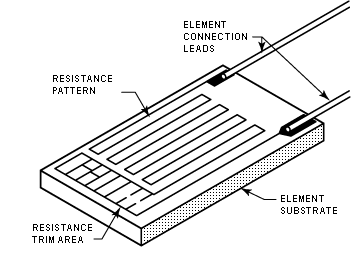 |
Platinum RTD elements take either of two forms: wire wound (see Fig. 1) or thin film. RdF wire-wound elements are made primarily by winding a very fine strand of platinum wire into a coil until there is enough material to equal 100Ω of resistance. The coil is then inserted into a mandrel and powder is packed around it to prevent the sensor from shorting and to provide vibration resistance. This is a time-consuming method and all work is done manually under a microscope, but the result is a strain-free design. Strain-free elements are required for industrial measurements below –200°C. They also insure superior interchangeablity and stability to the highest temperatures.
| Figure 1. The coiled element sensor, made by inserting the helical sensing wires into a packed powder-filled insulating mandrel, provides a strain-free sensing element. |
Thin film elements (see Fig. 2) are manufactured by depositing a thin layer of platinum or its alloys on a ceramic substrate. The metal is deposited in a specific pattern and trimmed to the final resistance. The elements are coated with a glass-like material for mechanical and moisture protection.
An advantage of the thin film sensor is that a greater resistance can be placed in a smaller area; 1000Ω RTD sensors are readily available. Thin film sensors are susceptible to a small thermal expansion mismatch strain that limits maximum temperature coefficient to the 0.00385 Ω/Ω/°C International grade. On the plus side, 1000Ω elements offer the advantage of increased resolution per degree of temperature, and errors due to lead wire resistance are minimized. Although 1000Ω thin film elements would appear preferable, most of the older electronics are designed to accept only the 100Ω sensor. 100, 500 and 1000 Ω thin-films, now produced world-wide, incorporate platinum advantages so efficiently no other metal can compete.
|
|
 |
| Figure 2. The thin film sensing element is made by depositing a thin layer of platinum in a resistance pattern on a ceramic substrate. A glassy layer is applied for seal and protection. |
|




